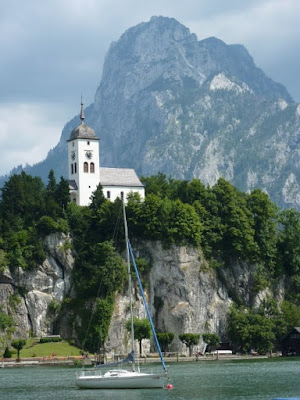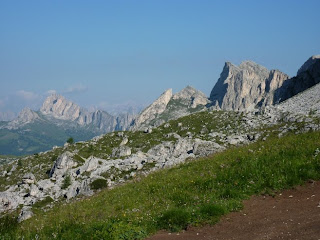 |
Rose and other flower garden
|
 |
Vicki by a unicorn we think we have a photo
of from '89
|
 |
Mirabelle view
|
 |
Us, in Mirabelle, with the Salzburg High
Fortress behind us
|
...recounts the retirement travels of Mark and Vicki Sherouse since 2008...in Asia and the Pacific, New Zealand, Europe, South America, and Africa, as well as the US and Canada. Our website, with much practical information, is: https://sites.google.com/site/theroadgoeseveron/.Contact us at mark.sherouse@gmail.com or vsherouse@gmail.com.
 |
Traditional boats on Halstattsee; we had wanted to visit
Hallstatt again, as we did in 1989, but there was no RV
parking, and the natives did not seem friendly
|
 |
One sees much evidence of logging in the Alps--logging
trucks like this one, mills scattered here and there; but
never any clear-cuts or anything unsightly
|
 |
A canoe-catcher on the river (weir)
|
 |
On Traunsee, approaching Gmund, the Traunkirchen, which
is pictured prominently in Sound of Music
|
 |
Closer-up of Traunkirchen and its amazing
backdrop north of the Dachstein Gruppe
|
 |
Market square in pretty Mondsee
|
 |
The Mondsee Basilika, where Maria and the
Captain married
|
 |
Interior
|
 |
Mondsee and more of the Dachsteins
|
 |
Austrians seem to think they have an identity
problem (I think a Jim Carey line in Dumb
and Dumber led to this)
|
 |
Up on the Hohenalpenstrasse, the high alpine road, part of
which shoots over to the Grossglockner; looking back
toward Heiligenblut |
 |
The Kaiser Franz Josef high place--visitor center,
restaurants, cafes, a 5-story parking garage
|
 |
Us at the RV parking lot; the weather steadily improved for
a couple hours
|
 |
The Grossglockner's major glacier, one of the largest in
the Alps
|
 |
And, finally, a good look at the summit
|
 |
Complete view of the glacer and the summit, and also the
wand; although only 12,000 feet or so, it's a serious
mountain
|
 |
Love the signage
|
 |
Ditto
|
 |
Click to enlarge and see people on the glacier below...
probably not very smart people
|
 |
A walk near the clouds
|
 |
Distant crags
|
 |
And not so distant
|
 |
Features almost like the American southwest
|
 |
And more like the Alps
|
 |
A popular hiking valley in the national park
|
 |
It turned into a cloudy day, but no less exhiliarating
|
 |
More clouds moving in
|
 |
Italian Park Rangers, enforcement-types (note side-arms)
|
 |
This whole part of Italy was earlier part of the Austrian
empire--till 1919--Mussolini did his best to Italianize the
place, but it is still bilingual...the rangers above spoke
German
|
 |
Peaks and crags everywhere, much limestone
|
 |
In a small town
|
 |
Tower on a larger mini-massif
|
 |
And other features too
|
 |
Back down in a valley, before heading up to Cortina
|
 |
I am not sure whether it is boasting or serious road
information, but they number the hair-pin turns on these
roads
|
 |
The road to the Pass Giua had 28 such hair-pins; the roads
are good, however, nice and wide; no tour busses up here
|
 |
We found an aire, of sorts, just beyond this peak, and
stopped for the night
|
 |
Other views in the vicinity
|
 |
Parked at our "aire"
|
 |
Table with a view: tomatoes and mozzarella and veal
piccata
|
 |
The view
|
 |
Our campsite, a Tyrolean lay-by, en route to Brenner Pass
|
 |
Mountains on the Brenner Pass
|
 |
The Pass is littered with old fortresses, to guard the pass,
and to charge tolls...nowadays, a mere 8 euros
|
 |
Another
|